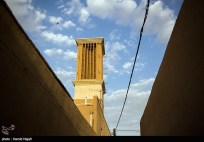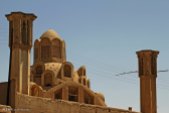A windcatcher or bâdgir (in Persian: bâd “wind” and gir “catcher”) is a traditional Persian architectural element to create natural ventilation in buildings. They have remained present in many countries and can be found in traditional Persian-influenced architecture throughout the Middle East, including in the Arab states of the Persian Gulf (mostly Bahrain and Dubai), Pakistan, and Afghanistan.
Most windcatchers belong to old residential houses, mosques and urban reservoirs, e.g. in Persian architecture they were used as a refrigerating device at traditional water reservoirs (ab anbars) to store water near freezing temperatures in summer. Regardless of its utility, the height and adornments of these windcatchers used to represent the owner’s distinction and social standing.
Recently the windcatcher approach has been adopted in Western architecture, such as in the visitor center at Zion National Park, Utah and at Kensington Oval cricket ground in Barbados.
Below windcatchers in the cities of Yazd and Kashan (Yazd and Isfahan Provinces) by Hamid Najafi for Tasnim News and by Hoda Asghari for Mehr News.
Windcatchers come in various designs: uni-directional, bi-directional, and multi-directional and work pretty much like modern air conditioning system. At the top of the windcatcher are several directional ports – usually four open towards four direction. When the port facing the prevailing wind is opened, air is pushed down the shaft and into the building. At the base of the tower is a pool of water provided by aqueducts called karez (or qanat), over which the air is allowed to pass. As the warm air passes over the surface of the water, the air cools through evaporative cooling. At night, cold air is sucked into the house thereby cooling it naturally.
Windcatchers can also act in reverse. By closing all ports but the one facing away from the incoming wind, air is drawn upwards using a combination of Bernoulli’s Principle and Coanda effect. The negative pressure pulls hot air down into the karez tunnel and is cooled by coming into contact with the cool earth and cold water running through it. At this point, the cooled air is introduced into the building. By facing windcatchers away from the wind, dust and sand blowing in from the desert can also be kept away from buildings.
The evaporative cooling effect is strongest in the driest climates, such as on the Iranian plateau, leading to the ubiquitous use of windcatchers in drier areas such as Yazd, Kerman, Kashan, Sirjan, Nain, and Bam.
Shish-khans (small windcatchers) can still be seen on top of water reservoirs in Qazvin and other northern cities in Iran. These seem to function more as ventilators than as the temperature regulators seen in the central deserts of Iran.
Sources: Tasnim News (Yazd), Mehr News (Kashan), Wikipedia, Historical Iran, Amusing Planet







































